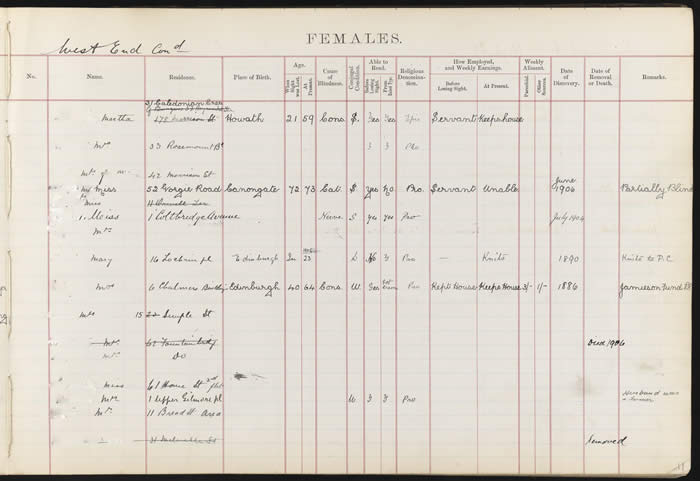Projects
Seeing Our History
In 2014, LHSA contributed to a Royal National Institutue of Blind People (RNIB) Scotand project entitled 'Seeing Our History - Living with Sight Loss in Edwardian Edinburgh and the Lothians'. Supported by the Heritage Lottery Fund, this project aimed to bring together volunteers from many different backgrounds to help to unlock the history of what life was like for blind and partially-sighted people in Edinburgh and other parts of Scotland during the Edwardian period - a largely neglected area of research. It also aimed to open up the world of archival research to a group of people who have traditionally been excluded.
About the RNIB
RNIB Edinburgh and Lothians began as the Edinburgh Society for Promoting Reading Amongst the Blind in November 1857, and by 1863 the Society was covering the areas north of the Forth to Stirling and Fife and as far as Dunbar in the south. Soon after the start of the twentieth century, the organisation changed its name to the Society for the Welfare and Teaching of the Blind (Edinburgh and South-East Scotland) and from 1930 the Society occupied premises at 4 Coates Crescent, Edinburgh.
LHSA now holds the records of RNIB Edinburgh and Lothians, as well as papers of related organisations, published books and collected secondary source material.
About the project
The project was based around the Register of the Outdoor Blind for Edinburgh and the Lothians, dated from around 1903 to 1910. The Register was used to document the lives of 1170 blind or partially sighted individuals, and covers a period when support for sight-related disability was limited. It contains details about these individuals including: name; address; place of birth; age when sight was lost; cause of blindness; marital status; how employed; weekly earnings before losing sight and weekly income after; and date of death.
LHSA volunteers transcribed the Register, which enabled eight research volunteers, including two with visual impairments, to identify individuals to delve further into. Using valuation rolls, censuses and birth, death and marriage records, the researchers built up the life stories of the individuals on the Register, giving these otherwise anonymous names flesh and blood.
Outcomes
The project pieced togethr ten detailed case studies and published them in two books: Feeling Our History and Hearing Our History. Each book is available in a variety of accessible formats, including large print, audio and braille. The project also produced podcasts featuring original music based on the life histories researched, which can be listened to on RNIB Connect Radio.
 |
Designed by the Learning Technology Section, © The University of Edinburgh

